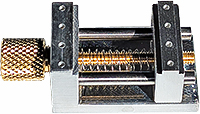
EM-Tec MCS-1 & MCS-0.1 Magnification Calibration Standards
Product numbers: #31-T31000-U, #31-T31000-1, #31-T31000-2, #31-T31000-6, #31-T31000-8, #31-T31000-10
Product numbers: #31-C31000-U, #31-C31000-1, #31-C31000-2, #31-C31000-6, #31-C31000-8, #31-C31000-10
Product numbers: #31-T32000-U, #31-T32000-1, #31-T32000-2, #31-T32000-6, #31-T32000-8, #31-T32000-10
Product numbers: #31-C32000-U, #31-C32000-1, #31-C32000-2, #31-C32000-6, #31-C32000-8, #31-C32000-10
Introduction
The EM-Tec Magnification Calibration Standards MCS) are intended for magnification calibration of a range of microscopes, including SEM, Auger, ESCA, SIMS, FIB, AFM, SPM and reflected LM. Line patterns with calibrated features are used for calibration and critical dimension measurements. The zeros in the feature sizes can be used for astigmatism correction. Available with two range of features sizes and either traceable of individually certified versions. The EM-Tec MCS standard offer many advantages over other calibration standards:
- All features in a single ultra-flat plane
- Constructed from non-outgassing materials (metal on silicon)
- Excellent signal to noise ratio
- Fully conductive materials
- Compatible with both SE and BSE
- Wider range of features to accurately calibrate low to high magnification ranges
- Can be cleaned with plasma cleaning
- Accuracy 0.7% or better
- Cost effcient
- All standards include a certificate
Construction of the EM-Tec MCS-1 and MCS-0.1 calibration standard
The EM-Tec MCS magnification calibration standards are manufactured using state of the art MEMS manufacturing techniques. For improved planarity, an ultra-flat Si substrate with deposited chromium and gold features is used. The features size ranges from 2.5mm down to 100nm on a single ultra-flat compact standard. High contrast 50nm thick chromium is used for the larger features down to 2.5µm. For the smaller features, from 1µm to 100nm, 50nm gold over a 20nm chromium base is used. This ensures excellent signal at all magnifications.
Feature sizes on the Em-Tec MCS-1TR and EM-Tec MCS-1CF are:
- 2500, 250 and 2.5µm
- 1000, 100, 10 and 1µm
- 500 and 5µm
Features sizes on the EM-Tec MCS-0.1TR and EM-Tec MCS-0.1CF are:
- 2500, 250, 2.5 and 0.25µm
- 1000, 100, 10, 1 and 0.1µm
- 500, 5 and 0.5µm
Each standard comes with a unique identification number consisting of a wafer ID and a position ID.
Traceability and certification
Traceable version: The traceable version of the EM-Tec MCS standard are produced by measuring randomly selected, 5 individual standards per wafer against a NIST measured standard. The average of measurements determines the level of uncertainty. By method of fabrication, the remaining standards on the same wafer are therefore traceable. Each standard comes with a wafer level certificate of traceability with the calibration results.
Certified version: The certified EM-Tec MCS magnification calibration standards are individually calibrated against a NIST measured standard. The uncertainty of the individually certified standards is better (lower) than the traceable standards. Each individually calibrated standard comes with a unique calibration certificate.
Using the EM-Tec MCS standards
The EM-Tec MCS standard have been designed to cover 4 order of magnitude in magnification. The largest feature for the lowest magnification is 2.5mm. Bring the 2.5mm square in full view. By doubling the magnification, the next feature is visible. With four steps the center features come in view; starting at 10µm and ending at 100nm. By choosing the suitable feature size, the complete magnification range from 5x to 200,000x can be calibrated with the EM-Tec MCS-0.1. (5x to 20,000x for the EM-Tec MCS-1.)
Cleaning
Try to use the same area for focusing and optimizing the SEM before measurements. This will minimise contamination of other surface areas on the standard. When it becomes necessary to clean the EM-Tec MCS standard, follow these guidelines:
- Remove dust and other lose particles with compressed dry filtered inert gas (nitrogen). As an alternative a duster with compressed gas can be used, but be careful not to freeze the surface.
- Rinse with distilled water followed by a rinse with isopropanol and let dry. Avoid liquids that leave a residue.
- For hydrocarbon residues (contamination) and finger prints it is best to use a gentle oxygen plasma cleaner.
- Do not use mechanical methods such ad brushing, scrubbing or polishing.
Certification end date
There is no end date on the certificates for the EM-Tec MCS. Due to the construction of Cr and Au on Si, the products are considered chemically stable under normal conditions of use. Since the standard are not mechanically touched, the only deterioration is contamination. We therefore expect the lifetime of this standard up to 10 years and beyond in clean systems. The re-certification period should be determined by the end-user depending use, storing, handling and the general condition of the standard. If the standard is subject to a catastrophic event which damages the standard, it needs to be replaced.
A re-calibration service is not offered for this certified calibration standard; individual re-certification is substantially more expensive than a new certified standard. Recalibration or re-certification can only be performed by purchasing a new MCS standard.
TSB 31-T3100 EM-Tec MCS-1 and MCS-0.1 magnification calibration standard Revision 3





